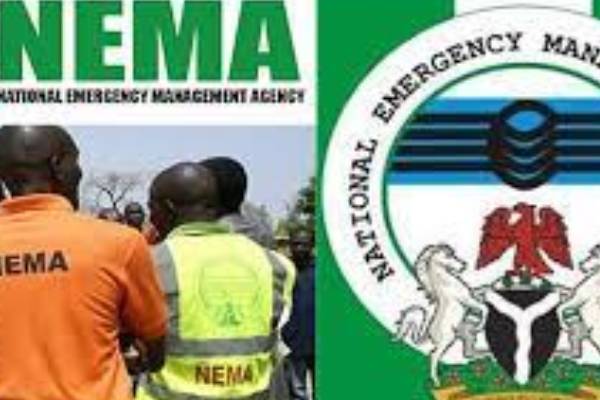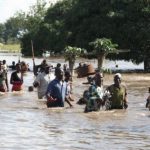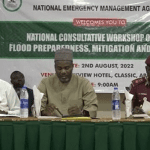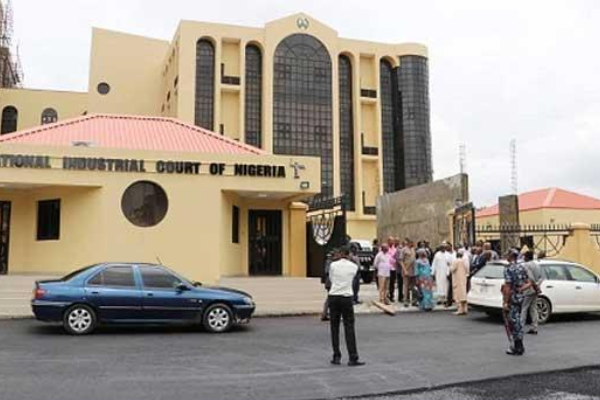The National Emergency Management Agency (NEMA) has said that 13 States will experience heavy floods in 2022.
The States, according to the agency are: Adamawa, Taraba, Benue, Niger, Nasarawa, Kebbi, Kogi, Edo, Delta, Anambra, Cross River, Rivers and Bayelsa.
The agency also said the country should expect Kainji, Shiroro and Jebba dams to overflow between now and the end of October.
The agency explained that the situation may be worsened due to the release of excess water from the Lagdo dam in the Republic of Cameroon by its operators.
The Director General of NEMA, Mustapha Ahmed revealed these in Abuja during an emergency meeting aimed at reviewing the emergency and planning for further action by all responders.
He said: “Based on our communication with the Nigeria Hydrological Services Agency (NIHSA), the Lagdo dam operators in the Republic of Cameroon have commenced the release of excess water from the reservoir by 13th September 2022.
“We are aware that the released water cascades down to Nigeria through River Benue and its tributaries thereby inundating communities that have already been impacted by heavy precipitation.
“The released water complicates the situation further downstream as Nigeria’s inland reservoirs including Kainji, Jebba, and Shiroro are also expected to overflow between now and October ending according to NIHSA.
“According to NIHSA, Kainji and Jebba dams have already started spilling excess water from their reservoirs.
“This will have serious consequences on frontline States and communities along the courses of rivers Niger and Benue.
“These States include, Adamawa, Taraba, Benue, Niger, Nasarawa, Kebbi and Kogi states.
“Niger Delta states including Edo, Delta, Anambra, Cross River, Rivers and Bayelsa are expected to record heavy floods due to predicted above normal rains coupled with the combined waters of rivers Niger and Benue as they empty into the region.”
On the impact of the flood, he said: “Quite a lot of of our communities are passing through a challenging moment in respect of the flood disaster that has hit many states of our dear country.
“So far, it is on record that 29 States including the FCT have experienced heavy flooding with more than 500,000 persons already affected.
“Our record indicates that more than 300 lives have been lost, over 500 persons are seriously injured with more than 100,000 others displaced and living either in temporary shelters including schools, other public buildings and amongst benevolent host families.
He also advised State governments to evacuate those at risk and stockpile food and non-food items ahead of the floods.
He said: “I want to advise all the governments of the frontline states to move away communities at risk of inundation, identify safe higher grounds for evacuation of persons and preposition adequate stockpiles of food and non-food items, potable water, hygiene, safety and security to enable them a fair level of comfort during periods of possible displacement.
“These actions become necessary as we collectively work towards a lasting solution to the annual threats of floods.”
On efforts made to mitigate the impacts of the flood, the DG said all NEMA staff that were on leave have been recalled to the office because of the present emergency.
He also said motorised and inflatable boats for search and rescue as well as mobile water purification plants to provide portable water where sources of drinking water have been compromised have been deployed to the most affected states.
The National Emergency Management Agency (NEMA) has said that 13 States will experience heavy floods in 2022.
The States, according to the agency are: Adamawa, Taraba, Benue, Niger, Nasarawa, Kebbi, Kogi, Edo, Delta, Anambra, Cross River, Rivers and Bayelsa.
The agency also said the country should expect Kainji, Shiroro and Jebba dams to overflow between now and the end of October.
The agency explained that the situation may be worsened due to the release of excess water from the Lagdo dam in the Republic of Cameroon by its operators.
The Director General of NEMA, Mustapha Ahmed revealed these in Abuja during an emergency meeting aimed at reviewing the emergency and planning for further action by all responders.
He said: “Based on our communication with the Nigeria Hydrological Services Agency (NIHSA), the Lagdo dam operators in the Republic of Cameroon have commenced the release of excess water from the reservoir by 13th September 2022.
“We are aware that the released water cascades down to Nigeria through River Benue and its tributaries thereby inundating communities that have already been impacted by heavy precipitation.
“The released water complicates the situation further downstream as Nigeria’s inland reservoirs including Kainji, Jebba, and Shiroro are also expected to overflow between now and October ending according to NIHSA.
“According to NIHSA, Kainji and Jebba dams have already started spilling excess water from their reservoirs.
“This will have serious consequences on frontline States and communities along the courses of rivers Niger and Benue.
“These States include, Adamawa, Taraba, Benue, Niger, Nasarawa, Kebbi and Kogi states.
“Niger Delta states including Edo, Delta, Anambra, Cross River, Rivers and Bayelsa are expected to record heavy floods due to predicted above normal rains coupled with the combined waters of rivers Niger and Benue as they empty into the region.”
On the impact of the flood, he said: “Quite a lot of of our communities are passing through a challenging moment in respect of the flood disaster that has hit many states of our dear country.
“So far, it is on record that 29 States including the FCT have experienced heavy flooding with more than 500,000 persons already affected.
“Our record indicates that more than 300 lives have been lost, over 500 persons are seriously injured with more than 100,000 others displaced and living either in temporary shelters including schools, other public buildings and amongst benevolent host families.
He also advised State governments to evacuate those at risk and stockpile food and non-food items ahead of the floods.
He said: “I want to advise all the governments of the frontline states to move away communities at risk of inundation, identify safe higher grounds for evacuation of persons and preposition adequate stockpiles of food and non-food items, potable water, hygiene, safety and security to enable them a fair level of comfort during periods of possible displacement.
“These actions become necessary as we collectively work towards a lasting solution to the annual threats of floods.”
On efforts made to mitigate the impacts of the flood, the DG said all NEMA staff that were on leave have been recalled to the office because of the present emergency.
He also said motorised and inflatable boats for search and rescue as well as mobile water purification plants to provide portable water where sources of drinking water have been compromised have been deployed to the most affected states.
The National Emergency Management Agency (NEMA) has said that 13 States will experience heavy floods in 2022.
The States, according to the agency are: Adamawa, Taraba, Benue, Niger, Nasarawa, Kebbi, Kogi, Edo, Delta, Anambra, Cross River, Rivers and Bayelsa.
The agency also said the country should expect Kainji, Shiroro and Jebba dams to overflow between now and the end of October.
The agency explained that the situation may be worsened due to the release of excess water from the Lagdo dam in the Republic of Cameroon by its operators.
The Director General of NEMA, Mustapha Ahmed revealed these in Abuja during an emergency meeting aimed at reviewing the emergency and planning for further action by all responders.
He said: “Based on our communication with the Nigeria Hydrological Services Agency (NIHSA), the Lagdo dam operators in the Republic of Cameroon have commenced the release of excess water from the reservoir by 13th September 2022.
“We are aware that the released water cascades down to Nigeria through River Benue and its tributaries thereby inundating communities that have already been impacted by heavy precipitation.
“The released water complicates the situation further downstream as Nigeria’s inland reservoirs including Kainji, Jebba, and Shiroro are also expected to overflow between now and October ending according to NIHSA.
“According to NIHSA, Kainji and Jebba dams have already started spilling excess water from their reservoirs.
“This will have serious consequences on frontline States and communities along the courses of rivers Niger and Benue.
“These States include, Adamawa, Taraba, Benue, Niger, Nasarawa, Kebbi and Kogi states.
“Niger Delta states including Edo, Delta, Anambra, Cross River, Rivers and Bayelsa are expected to record heavy floods due to predicted above normal rains coupled with the combined waters of rivers Niger and Benue as they empty into the region.”
On the impact of the flood, he said: “Quite a lot of of our communities are passing through a challenging moment in respect of the flood disaster that has hit many states of our dear country.
“So far, it is on record that 29 States including the FCT have experienced heavy flooding with more than 500,000 persons already affected.
“Our record indicates that more than 300 lives have been lost, over 500 persons are seriously injured with more than 100,000 others displaced and living either in temporary shelters including schools, other public buildings and amongst benevolent host families.
He also advised State governments to evacuate those at risk and stockpile food and non-food items ahead of the floods.
He said: “I want to advise all the governments of the frontline states to move away communities at risk of inundation, identify safe higher grounds for evacuation of persons and preposition adequate stockpiles of food and non-food items, potable water, hygiene, safety and security to enable them a fair level of comfort during periods of possible displacement.
“These actions become necessary as we collectively work towards a lasting solution to the annual threats of floods.”
On efforts made to mitigate the impacts of the flood, the DG said all NEMA staff that were on leave have been recalled to the office because of the present emergency.
He also said motorised and inflatable boats for search and rescue as well as mobile water purification plants to provide portable water where sources of drinking water have been compromised have been deployed to the most affected states.
The National Emergency Management Agency (NEMA) has said that 13 States will experience heavy floods in 2022.
The States, according to the agency are: Adamawa, Taraba, Benue, Niger, Nasarawa, Kebbi, Kogi, Edo, Delta, Anambra, Cross River, Rivers and Bayelsa.
The agency also said the country should expect Kainji, Shiroro and Jebba dams to overflow between now and the end of October.
The agency explained that the situation may be worsened due to the release of excess water from the Lagdo dam in the Republic of Cameroon by its operators.
The Director General of NEMA, Mustapha Ahmed revealed these in Abuja during an emergency meeting aimed at reviewing the emergency and planning for further action by all responders.
He said: “Based on our communication with the Nigeria Hydrological Services Agency (NIHSA), the Lagdo dam operators in the Republic of Cameroon have commenced the release of excess water from the reservoir by 13th September 2022.
“We are aware that the released water cascades down to Nigeria through River Benue and its tributaries thereby inundating communities that have already been impacted by heavy precipitation.
“The released water complicates the situation further downstream as Nigeria’s inland reservoirs including Kainji, Jebba, and Shiroro are also expected to overflow between now and October ending according to NIHSA.
“According to NIHSA, Kainji and Jebba dams have already started spilling excess water from their reservoirs.
“This will have serious consequences on frontline States and communities along the courses of rivers Niger and Benue.
“These States include, Adamawa, Taraba, Benue, Niger, Nasarawa, Kebbi and Kogi states.
“Niger Delta states including Edo, Delta, Anambra, Cross River, Rivers and Bayelsa are expected to record heavy floods due to predicted above normal rains coupled with the combined waters of rivers Niger and Benue as they empty into the region.”
On the impact of the flood, he said: “Quite a lot of of our communities are passing through a challenging moment in respect of the flood disaster that has hit many states of our dear country.
“So far, it is on record that 29 States including the FCT have experienced heavy flooding with more than 500,000 persons already affected.
“Our record indicates that more than 300 lives have been lost, over 500 persons are seriously injured with more than 100,000 others displaced and living either in temporary shelters including schools, other public buildings and amongst benevolent host families.
He also advised State governments to evacuate those at risk and stockpile food and non-food items ahead of the floods.
He said: “I want to advise all the governments of the frontline states to move away communities at risk of inundation, identify safe higher grounds for evacuation of persons and preposition adequate stockpiles of food and non-food items, potable water, hygiene, safety and security to enable them a fair level of comfort during periods of possible displacement.
“These actions become necessary as we collectively work towards a lasting solution to the annual threats of floods.”
On efforts made to mitigate the impacts of the flood, the DG said all NEMA staff that were on leave have been recalled to the office because of the present emergency.
He also said motorised and inflatable boats for search and rescue as well as mobile water purification plants to provide portable water where sources of drinking water have been compromised have been deployed to the most affected states.
The National Emergency Management Agency (NEMA) has said that 13 States will experience heavy floods in 2022.
The States, according to the agency are: Adamawa, Taraba, Benue, Niger, Nasarawa, Kebbi, Kogi, Edo, Delta, Anambra, Cross River, Rivers and Bayelsa.
The agency also said the country should expect Kainji, Shiroro and Jebba dams to overflow between now and the end of October.
The agency explained that the situation may be worsened due to the release of excess water from the Lagdo dam in the Republic of Cameroon by its operators.
The Director General of NEMA, Mustapha Ahmed revealed these in Abuja during an emergency meeting aimed at reviewing the emergency and planning for further action by all responders.
He said: “Based on our communication with the Nigeria Hydrological Services Agency (NIHSA), the Lagdo dam operators in the Republic of Cameroon have commenced the release of excess water from the reservoir by 13th September 2022.
“We are aware that the released water cascades down to Nigeria through River Benue and its tributaries thereby inundating communities that have already been impacted by heavy precipitation.
“The released water complicates the situation further downstream as Nigeria’s inland reservoirs including Kainji, Jebba, and Shiroro are also expected to overflow between now and October ending according to NIHSA.
“According to NIHSA, Kainji and Jebba dams have already started spilling excess water from their reservoirs.
“This will have serious consequences on frontline States and communities along the courses of rivers Niger and Benue.
“These States include, Adamawa, Taraba, Benue, Niger, Nasarawa, Kebbi and Kogi states.
“Niger Delta states including Edo, Delta, Anambra, Cross River, Rivers and Bayelsa are expected to record heavy floods due to predicted above normal rains coupled with the combined waters of rivers Niger and Benue as they empty into the region.”
On the impact of the flood, he said: “Quite a lot of of our communities are passing through a challenging moment in respect of the flood disaster that has hit many states of our dear country.
“So far, it is on record that 29 States including the FCT have experienced heavy flooding with more than 500,000 persons already affected.
“Our record indicates that more than 300 lives have been lost, over 500 persons are seriously injured with more than 100,000 others displaced and living either in temporary shelters including schools, other public buildings and amongst benevolent host families.
He also advised State governments to evacuate those at risk and stockpile food and non-food items ahead of the floods.
He said: “I want to advise all the governments of the frontline states to move away communities at risk of inundation, identify safe higher grounds for evacuation of persons and preposition adequate stockpiles of food and non-food items, potable water, hygiene, safety and security to enable them a fair level of comfort during periods of possible displacement.
“These actions become necessary as we collectively work towards a lasting solution to the annual threats of floods.”
On efforts made to mitigate the impacts of the flood, the DG said all NEMA staff that were on leave have been recalled to the office because of the present emergency.
He also said motorised and inflatable boats for search and rescue as well as mobile water purification plants to provide portable water where sources of drinking water have been compromised have been deployed to the most affected states.
The National Emergency Management Agency (NEMA) has said that 13 States will experience heavy floods in 2022.
The States, according to the agency are: Adamawa, Taraba, Benue, Niger, Nasarawa, Kebbi, Kogi, Edo, Delta, Anambra, Cross River, Rivers and Bayelsa.
The agency also said the country should expect Kainji, Shiroro and Jebba dams to overflow between now and the end of October.
The agency explained that the situation may be worsened due to the release of excess water from the Lagdo dam in the Republic of Cameroon by its operators.
The Director General of NEMA, Mustapha Ahmed revealed these in Abuja during an emergency meeting aimed at reviewing the emergency and planning for further action by all responders.
He said: “Based on our communication with the Nigeria Hydrological Services Agency (NIHSA), the Lagdo dam operators in the Republic of Cameroon have commenced the release of excess water from the reservoir by 13th September 2022.
“We are aware that the released water cascades down to Nigeria through River Benue and its tributaries thereby inundating communities that have already been impacted by heavy precipitation.
“The released water complicates the situation further downstream as Nigeria’s inland reservoirs including Kainji, Jebba, and Shiroro are also expected to overflow between now and October ending according to NIHSA.
“According to NIHSA, Kainji and Jebba dams have already started spilling excess water from their reservoirs.
“This will have serious consequences on frontline States and communities along the courses of rivers Niger and Benue.
“These States include, Adamawa, Taraba, Benue, Niger, Nasarawa, Kebbi and Kogi states.
“Niger Delta states including Edo, Delta, Anambra, Cross River, Rivers and Bayelsa are expected to record heavy floods due to predicted above normal rains coupled with the combined waters of rivers Niger and Benue as they empty into the region.”
On the impact of the flood, he said: “Quite a lot of of our communities are passing through a challenging moment in respect of the flood disaster that has hit many states of our dear country.
“So far, it is on record that 29 States including the FCT have experienced heavy flooding with more than 500,000 persons already affected.
“Our record indicates that more than 300 lives have been lost, over 500 persons are seriously injured with more than 100,000 others displaced and living either in temporary shelters including schools, other public buildings and amongst benevolent host families.
He also advised State governments to evacuate those at risk and stockpile food and non-food items ahead of the floods.
He said: “I want to advise all the governments of the frontline states to move away communities at risk of inundation, identify safe higher grounds for evacuation of persons and preposition adequate stockpiles of food and non-food items, potable water, hygiene, safety and security to enable them a fair level of comfort during periods of possible displacement.
“These actions become necessary as we collectively work towards a lasting solution to the annual threats of floods.”
On efforts made to mitigate the impacts of the flood, the DG said all NEMA staff that were on leave have been recalled to the office because of the present emergency.
He also said motorised and inflatable boats for search and rescue as well as mobile water purification plants to provide portable water where sources of drinking water have been compromised have been deployed to the most affected states.
The National Emergency Management Agency (NEMA) has said that 13 States will experience heavy floods in 2022.
The States, according to the agency are: Adamawa, Taraba, Benue, Niger, Nasarawa, Kebbi, Kogi, Edo, Delta, Anambra, Cross River, Rivers and Bayelsa.
The agency also said the country should expect Kainji, Shiroro and Jebba dams to overflow between now and the end of October.
The agency explained that the situation may be worsened due to the release of excess water from the Lagdo dam in the Republic of Cameroon by its operators.
The Director General of NEMA, Mustapha Ahmed revealed these in Abuja during an emergency meeting aimed at reviewing the emergency and planning for further action by all responders.
He said: “Based on our communication with the Nigeria Hydrological Services Agency (NIHSA), the Lagdo dam operators in the Republic of Cameroon have commenced the release of excess water from the reservoir by 13th September 2022.
“We are aware that the released water cascades down to Nigeria through River Benue and its tributaries thereby inundating communities that have already been impacted by heavy precipitation.
“The released water complicates the situation further downstream as Nigeria’s inland reservoirs including Kainji, Jebba, and Shiroro are also expected to overflow between now and October ending according to NIHSA.
“According to NIHSA, Kainji and Jebba dams have already started spilling excess water from their reservoirs.
“This will have serious consequences on frontline States and communities along the courses of rivers Niger and Benue.
“These States include, Adamawa, Taraba, Benue, Niger, Nasarawa, Kebbi and Kogi states.
“Niger Delta states including Edo, Delta, Anambra, Cross River, Rivers and Bayelsa are expected to record heavy floods due to predicted above normal rains coupled with the combined waters of rivers Niger and Benue as they empty into the region.”
On the impact of the flood, he said: “Quite a lot of of our communities are passing through a challenging moment in respect of the flood disaster that has hit many states of our dear country.
“So far, it is on record that 29 States including the FCT have experienced heavy flooding with more than 500,000 persons already affected.
“Our record indicates that more than 300 lives have been lost, over 500 persons are seriously injured with more than 100,000 others displaced and living either in temporary shelters including schools, other public buildings and amongst benevolent host families.
He also advised State governments to evacuate those at risk and stockpile food and non-food items ahead of the floods.
He said: “I want to advise all the governments of the frontline states to move away communities at risk of inundation, identify safe higher grounds for evacuation of persons and preposition adequate stockpiles of food and non-food items, potable water, hygiene, safety and security to enable them a fair level of comfort during periods of possible displacement.
“These actions become necessary as we collectively work towards a lasting solution to the annual threats of floods.”
On efforts made to mitigate the impacts of the flood, the DG said all NEMA staff that were on leave have been recalled to the office because of the present emergency.
He also said motorised and inflatable boats for search and rescue as well as mobile water purification plants to provide portable water where sources of drinking water have been compromised have been deployed to the most affected states.
The National Emergency Management Agency (NEMA) has said that 13 States will experience heavy floods in 2022.
The States, according to the agency are: Adamawa, Taraba, Benue, Niger, Nasarawa, Kebbi, Kogi, Edo, Delta, Anambra, Cross River, Rivers and Bayelsa.
The agency also said the country should expect Kainji, Shiroro and Jebba dams to overflow between now and the end of October.
The agency explained that the situation may be worsened due to the release of excess water from the Lagdo dam in the Republic of Cameroon by its operators.
The Director General of NEMA, Mustapha Ahmed revealed these in Abuja during an emergency meeting aimed at reviewing the emergency and planning for further action by all responders.
He said: “Based on our communication with the Nigeria Hydrological Services Agency (NIHSA), the Lagdo dam operators in the Republic of Cameroon have commenced the release of excess water from the reservoir by 13th September 2022.
“We are aware that the released water cascades down to Nigeria through River Benue and its tributaries thereby inundating communities that have already been impacted by heavy precipitation.
“The released water complicates the situation further downstream as Nigeria’s inland reservoirs including Kainji, Jebba, and Shiroro are also expected to overflow between now and October ending according to NIHSA.
“According to NIHSA, Kainji and Jebba dams have already started spilling excess water from their reservoirs.
“This will have serious consequences on frontline States and communities along the courses of rivers Niger and Benue.
“These States include, Adamawa, Taraba, Benue, Niger, Nasarawa, Kebbi and Kogi states.
“Niger Delta states including Edo, Delta, Anambra, Cross River, Rivers and Bayelsa are expected to record heavy floods due to predicted above normal rains coupled with the combined waters of rivers Niger and Benue as they empty into the region.”
On the impact of the flood, he said: “Quite a lot of of our communities are passing through a challenging moment in respect of the flood disaster that has hit many states of our dear country.
“So far, it is on record that 29 States including the FCT have experienced heavy flooding with more than 500,000 persons already affected.
“Our record indicates that more than 300 lives have been lost, over 500 persons are seriously injured with more than 100,000 others displaced and living either in temporary shelters including schools, other public buildings and amongst benevolent host families.
He also advised State governments to evacuate those at risk and stockpile food and non-food items ahead of the floods.
He said: “I want to advise all the governments of the frontline states to move away communities at risk of inundation, identify safe higher grounds for evacuation of persons and preposition adequate stockpiles of food and non-food items, potable water, hygiene, safety and security to enable them a fair level of comfort during periods of possible displacement.
“These actions become necessary as we collectively work towards a lasting solution to the annual threats of floods.”
On efforts made to mitigate the impacts of the flood, the DG said all NEMA staff that were on leave have been recalled to the office because of the present emergency.
He also said motorised and inflatable boats for search and rescue as well as mobile water purification plants to provide portable water where sources of drinking water have been compromised have been deployed to the most affected states.














